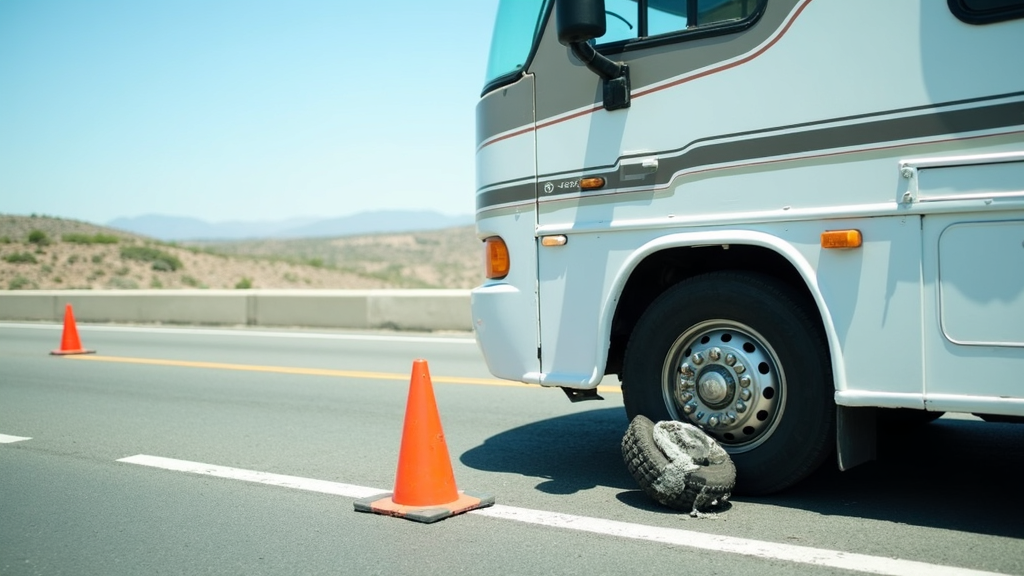Experiencing a blowout on your RV tire can be one of the most stressful things that can happen while you’re out on the road. When rubber shreds and the steering wheel shakes, it’s easy to panic, especially if you’ve never dealt with anything like this before. Knowing what to do can make all the difference in keeping you, your passengers, and your RV safe. I’ll walk you through every step you need to take if a tire blows out on your RV, so you feel more confident if the unexpected ever happens.

Understanding RV Tire Blowouts
A tire blowout happens when the tire suddenly loses air pressure, usually with a loud bang, flying rubber, and a jerking sensation in the steering. In RVs, blowouts can feel even more dramatic because of their size and weight. Unlike regular cars, RVs are more prone to instability during a blowout since they carry heavier loads and have a higher center of gravity.
One of the biggest reasons RV tires blow out is underinflation. When tires don’t have enough air, they heat up too much as you travel, leading to failure. Other reasons include putting too much weight on the tires, bumping into road debris, or driving on old or damaged rubber. Staying aware of these risks helps prevent some problems, but even careful RVers sometimes get caught off guard.
Immediate Actions to Take After a Blowout
The most important first step is to stay calm. Your instincts might tell you to hit the brakes hard, but that can actually make things worse. Here’s how to keep control and get yourself to safety smoothly:
- Grip the Steering Wheel Firmly: RVs tend to pull hard toward the side of the blown tire. Keep your hands steady and steer straight.
- Ease Off the Accelerator: Slowly lift your foot from the gas pedal without braking suddenly. Slamming the brakes could cause swerving or tipping.
- Let the RV Slow Down Naturally: Allow the RV to coast and decrease speed on its own while maintaining as straight a path as possible. Use your turn signals if safe.
- Guide Your RV to a Safe Spot: Watch for a shoulder or a wide, flat area well off the roadway. If you’re on an interstate, aim for the right shoulder. Avoid stopping in places with poor visibility or on curves.
- Activate Hazard Lights: Once you’re fully stopped, flip on your emergency flashers to alert other drivers to your situation.
Safety Steps Before You Inspect
Once you’ve parked safely, resist the urge to rush out and check the damage. Take a moment to check your surroundings. If you’re near fast-moving traffic, stay inside the RV and exit on the side away from traffic if possible. Set up safety triangles, cones, or flares behind your RV to give other drivers plenty of warning. A reflective vest is also smart, especially at night or in bad weather.
Inspecting the Damage
Check the blown tire for extra hazards. Look for exposed steel belts or sharp fragments of rubber. Walk around the RV to see if nearby tires, wheels, or parts of the RV body got damaged by blown debris. Sometimes a tire blowout will tear into wheel wells, wiring, or plumbing hidden underneath, so carefully poke your head under if you can do it safely.
A thorough check right now can save headaches later. Taking a few photos is smart for documentation with repair shops or if you need to work with your insurance.
Can You Change the Tire Yourself?
Many RVers like the idea of swapping a tire themselves, but it’s quite a bit tougher than changing a car tire. RV tires are much heavier, and the process requires strong tools and working space. Think about these points before trying it yourself:
- Do You Have a Proper Jack? Your jack needs to be rated for your RV’s full weight. A basic car jack won’t do the job safely.
- Where Are You Parked? Changing a tire on a hill or on soft gravel is risky. Always try to find stable, flat ground.
- Do You Have the Right Tools? That includes a sturdy lug wrench, working safety gear, and a properly inflated spare that matches the rest.
If you’re on a highway or just not sure, calling roadside assistance is usually safer and often faster. Many RV insurance policies offer this benefit, and services like Good Sam or AAA RV bring experienced help whenever you need it.
When to Call for Professional Help
Changing an RV tire yourself on the roadside can genuinely put you in harm’s way, even if you’ve done it before. If you don’t have the right gear, the situation doesn’t feel safe, or you doubt your own strength or ability, getting help from a pro is the best call. Tire blowouts can sometimes cause hidden problems, such as a bent rim or damage to the RV’s suspension. Roadside pros arrive with the right equipment and experience to get you back on the road with less risk.
It’s always a good idea to keep emergency contact numbers in the glove box and saved on your phone. Make sure your insurance card and roadside assistance details are easy to find, so you’re not left searching in an emergency.
Temporary Fixes and What Not to Do
Unlike a slow leak, a full-on blowout can’t be fixed with a plug kit or tire sealant. Trying to drive on a flat tire, even for a few yards, can destroy your wheel and seriously damage the RV’s frame or systems. Don’t try to hobble down the road to the next exit unless staying put is truly more dangerous. Instead, wait for help or, if you’re in an ultra-safe area with the right tools, swap in your spare to get to the nearest repair shop.
After the Event: Next Steps
Once you’re rolling again with a new or spare tire, keep a few extra steps in mind to prevent more trouble down the line:
- Check All Your Tires: If one blew out, the others could be close behind. Inspect for proper pressure, cracks, blisters, and uneven tread wear.
- Double Check Load Distribution: Blowouts may point to weight imbalance. Shift bulky gear so each tire does its fair share of work.
- Check for Damage Underneath: Look for ripped hoses, loose wires, or undercarriage scraps caused by the blowout.
- Replace With a Proper Tire: Make sure the new or spare tire matches the others in size, type, and weight rating to keep your RV rolling smoothly and safely.
Be sure to note the tire’s age and jot down any details about where and when the blowout happened. Good notes help for future reference or warranty help if you believe the tire was defective. If you plan to make a claim, hang onto the damaged tire just in case.
Tips to Avoid RV Tire Blowouts in the Future
Stopping RV tire blowouts is all about regular checks and smart habits. Preventive care can go a long way, so here are my top tips to keep you rolling with peace of mind:
- Keep Tabs on Tire Pressure: Don’t just check before a big trip; get in the habit of checking before every travel day. Always check when tires are cold for the most accurate reading.
- Watch the Age of Your Tires: If your tires are six years old or more—even with good tread—they should be replaced. Sun, heat, and weather break down rubber from the inside out.
- Weigh Your RV Regularly: Take your rig to a truck stop scale or RV service center and compare the numbers with your tire load ratings. Adjust your packing if you’re pushing the limits.
- Look Out for Debris and Potholes: Stay vigilant and try to spot road debris early; even small metal shards or pieces of glass can spell a quick end for a heavy RV tire.
- Do a Visual Once-Over Often: Before every trip, scan each tire for bubbling, cracking, or bulges on the sidewall. Swap out any questionable ones before you hit the road.
Frequently Asked Questions
Here are some questions I hear a lot about handling RV tire blowouts:
Question: What causes most RV tire blowouts?
Answer: The biggest factors are underinflation, carrying too much weight, running on old tires, and hitting road debris. Consistent checks and safe habits go a long way toward steering clear of blowouts.
Question: Is it safe to drive on a blown RV tire just to get off the road?
Answer: Only if you absolutely have to move to avoid immediate danger. Driving more than a few yards on a blown tire usually causes major damage.
Question: What’s the best way to keep from having RV tire blowouts?
Answer: Stick to a maintenance routine. Check pressure, tread, and tire age each travel day and whenever you stop during a long ride. Staying on top of this is your best insurance for safe travels.
Wrapping Up
Handling an RV tire blowout is all about staying cool, acting smoothly, and keeping your safety as top priority. Whether you fix it yourself or call in pros, preparation and knowing your personal limits make these tough situations less overwhelming. The best tool is always prevention—regular tire checks, proper gear in your RV, and a solid plan in mind.
The freedom of RV life is worth it, bumps and all. A little know-how and readiness ensure you’ll be back to enjoying the open road in no time, confident you can handle whatever comes your way.
